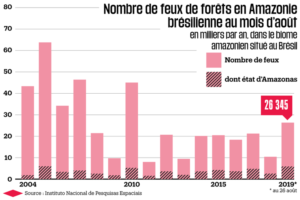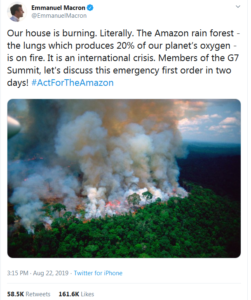by Jo Moreau, 26 août 2019 in Contrepoints
L’ avalanche d’articles, de photos et d’avis de personnalités de tous horizons sur les incendies qui ravagent l’Amazonie constitue une illustration parfaite du sale boulot de manipulation de l’opinion publique exercée par les médias, et porteur de l’amalgame trompeur diffusé jour après jour entre protection de l’environnement et réchauffement climatique.
La première chose qui a attiré mon attention est le rapport fait entre le nombre d’incendies constatés en 2019, avec la situation en… 2018. Il est à peine croyable qu’une comparaison aussi peu significative sur le plan statistique et trompeuse sur le plan historique ait été diffusée sans aucune réserve par tous les médias mondiaux, mais serve de surcroît les intérêts d’hommes et de femmes politiques, à commencer par le leader auto-proclamé de l’Union Européenne et porte-drapeau mondial de l’écologisme, j’ai nommé le président Macron.
Illustré par une photo « détournée », son récent tweet sur le sujet résume parfaitement l’amalgame entretenu par les sauveurs de la planète sur base de fake news :
« Notre maison brûle. Littéralement. L’Amazonie, le poumon de notre planète qui produit 20 % de notre oxygène, est en feu. C’est une crise internationale. Membres du G7, rendez-vous dans deux jours pour parler de cette urgence. »
Alors, soit le président Macron est mal informé, soit il suit aveuglément les avis très orientés d’ONG n’ayant aucune légitimité scientifique ou démocratique. Le problème est que la majorité de ceux qui nous gouvernent a une démarche identique.
Mais reprenons les choses dans l’ordre.
FAKE NEWS
Je place sous ce titre l’emploi par les médias ou sur les réseaux sociaux de photos parfois anciennes, non pas « fausses », mais tout à fait étrangères avec la situation actuelle en Amazonie.
Il s’agit d’une tactique souvent employée, destinée à émouvoir le public et l’orienter dans le sens voulu. Le choix des photos qui illustrent un article a une grande importance. Ainsi, les photos de dirigeants politiquement incorrects montrent souvent des visages grimaçants ou dans des poses peu avantageuses, tandis que les dirigeants idéologiquement corrects (aux yeux des médias) nous sont montrés souriants et sympathiques.
Mais l’emploi massif de ces photos « détournées » était tellement flagrant qu’après les avoir abondamment publiées, l’ensemble de la presse émit dans un deuxième temps des réserves prudentes quant à leur origine, ce qui lui permit accessoirement de se draper dans une démonstration émouvante d’objectivité.
DÉSINFORMATION
…
…
Voir aussi ici
(Une Amazonie bien commode pour la politique idiote de Macron)





